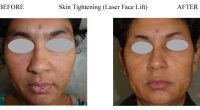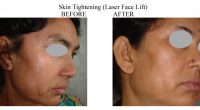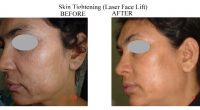Surgical face lift is becoming less common due to availability of new advanced laser & other skin tightening devices like radio frequency. Surgical face lift has disadvantage of permanent scars. Even newer technologies as laser & pixel radio frequency cannot eliminate these scars to satisfactory level. However, it is the only quick-fix solution to reverse age on once face. No surgical face lift is multiple sitting treatment. Change is slow & over few weeks to months. It does not leave any scars. In addition to skin tightening skin complexion is also improved. Skin rejuvenation is also done simultaneously. Obviously no surgical facelift is more preferred procedure as final result is undoubtedly superior.
A facelift is a cosmetic procedure to tighten and smooth unwanted slackened and loose facial and neck skin.
Facelift surgery is carried out under a general anaesthetic and usually requires a two night stay in hospital. There are various techniques that surgeons can use to perform this operation. For a typical facelift, the surgeon makes an incision high in the temple area (hidden by your hair). The incision follows the curve in front of the ear, round the earlobe and up behind the ear before gently curving back into the hair again. An incision may also be made under the chin if the operation includes lifting a sagging jawline. The facial skin is carefully separated from the muscles of the face and any excess fat removed. The facial muscles are the tightened and in some cases re-draped. The excess facial skin is then removed. Once surgery is complete, all the incisions are closed – sutures are used around the ear and surgical clips are used in the hair. Following the procedure you will be taken from the operating theatre into the Recovery Suite where you will be looked after until you are fully awake. After this, you will return to your room, where nursing staff will check your dressings and monitor your pulse and blood pressure at regular intervals. The anaesthetist will prescribe painkillers and you should take these regularly for the first week or so. Pain can slow down your recovery, so it is important to discuss any discomfort with the nursing staff. You may have drainage tubes under the skin of the face – these have bottles attached to them and are there to drain away any excess fluid. The drains are removed before you are discharged home. There may be a drip in one of your arms – this is to keep you well hydrated. This will be removed when you are able to drink a satisfactory amount. You will have wound dressings in place and tightly wrapped bandages around your head. The bandages are removed before you are discharged home.
After a facelift you are likely to have some discomfort/pain, swelling, and bruising. These are temporary and should subside after the first few weeks. You should follow your surgeon’s advice regarding how long to avoid driving but you certainly should not begin driving again until you are confident that you can safely perform an emergency stop without experiencing any discomfort. Your surgeon will also advise you on how long you are required to wear your supportive compression garment and whether it is to be worn day and night. You will receive a post-operative telephone call from the cosmetic surgery specialist nurse 1 – 2 days after your discharge home to ascertain your progress and well being. At your post-operative follow-up appointment your surgeon will assess your progress and give advice on when you can resume your normal activities. The length of time you will need to take off work will completely depend on your type of employment.
Facelift surgery is a commonly performed and generally safe procedure. However, all surgery carries an element of risk. The possible complications of any surgery can include an unexpected reaction to a general anaesthetic, excessive bleeding, infection and developing a blood clot (usually in a vein in the lower leg, known as a deep vein thrombosis). You will be left with visible scars following your surgery. Initially they will be red and slightly raised, but they should gradually soften and fade over the following months. Occasionally, bleeding under the skin causes further swelling and pain – this is known as a haematoma. In rare cases further surgery is required to remove the haematoma and to stop the bleeding. There are facial nerves that run from the ear across to the muscles of the face – these may be damaged during surgery, causing numbness and muscle weakness. These symptoms usually resolve on their own, but occasionally can be permanent.



